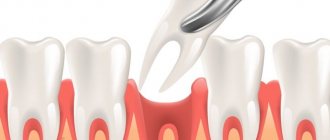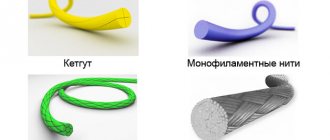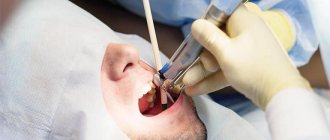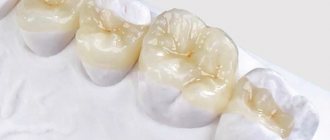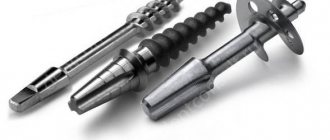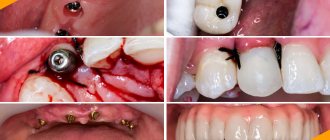One of the most popular modern technologies for restoring lost teeth is implantation. It appeared more than half a century ago and since then has been continuously improved, offering new materials and components, expanding the range of implants, developing simpler and more effective surgical protocols, increasing efficiency and safety.
Let's look at the pros and cons of dental implants. Today it is a painless and safe procedure that provides a number of advantages over other types of prosthetics:
- wide possibilities of prosthetics – with the help of implantation you can restore one tooth, several, and even the entire dentition,
- preservation of bone tissue - without chewing load, the jaw bone gradually atrophies, and implants, transferring the load to the jaw, stop this process,
- excellent aesthetics - any crowns can be installed on implants and the appearance of artificial teeth will be no different from natural ones,
- careful treatment of natural teeth - implantation does not require grinding down neighboring teeth, it does not affect them at all, and even (preserving the jaw from atrophy) prevents displacement and loosening,
- ease of use – implants feel exactly like your own teeth, you can easily get used to them in 1-2 days and do not cause any discomfort,
- complete restoration of chewing function and diction - there are no restrictions on food intake for implants (except for the period of their engraftment).
Of course, implantation also has some disadvantages, such as pain and discomfort in the first days after surgery, a rather long period of complete engraftment of the material, a small risk of complications (2-3%), as well as high cost, but nevertheless, implantation is becoming more and more is widely used as the cost of this procedure decreases and components become more accessible to the general public.
Stages of installing dental implants
The actual procedure for installing the implant lasts 30–60 minutes. The period of discomfort is 2–3 days after surgery. On days 7–8, the sutures are removed, and by this time, as a rule, the patient has no external traces (swelling) or complaints about sensations in the intervention area. However, this stage cannot be compared in duration to osteoplasty and osseointegration.
List of stages of dental restoration based on implants:
- Preparatory therapy. All infectious and inflammatory diseases of the oral cavity are treated. If it is superficial caries without complications, the procedure is performed in one visit. An advanced condition requires appropriate therapy. You are healthy? Then no preparation is needed.
- Diagnostics using radiography and tomography (if necessary). Based on the data obtained, a dental restoration plan is determined, a working method (protocol) is selected, as well as a specific implantation system.
- Manufacturing of a surgical implant template. Optional step. It takes several days. The event is relevant if you plan to install a large number of implants.
- Replenishment of missing bone material. An optional step, but in some cases you cannot do without it. Osteoplasty and sinus lift usually take from 2 to 6 months.
- Surgery to install implants.
- Installation of temporary crowns (for front teeth) or gum formers (for molars). The formation time of the soft tissues surrounding the upper part of the implant is 3–4 weeks.
- The process of implantation of artificial titanium roots into the jawbone, called osseointegration. The final integration of dental implants occurs within 2 to 6 months after their installation.
- Installation of permanent crowns, bridges, clasps.
Is it expensive to get teeth inserted?
Unfortunately, if you expect to receive the services of an orthopedic dentist under your insurance policy, then you will not be able to do this. Of course, if you belong to preferential categories of citizens, then you can use such medical care for free or receive substantial compensation. In other cases, you can only count on a tax deduction. Therefore, there is no big difference whether you go to a private or public dental clinic. Sometimes even commercial medical institutions hold promotions that will make prosthetics cheaper for you.
Implantation protocols
The term implies a combination of a program for the restoration of lost teeth, certain implantation techniques and a specific implant system (model, design, set of tools and materials). Different protocols may include all 7 stages listed above, or may be limited to 2–3 of them.
The most important factors in determining a protocol are:
- Number and positions of teeth to be restored (upper or lower jaw… incisors, premolars or molars).
- Oral health.
- Anatomical features of the maxillofacial region.
- Immunological status and regenerative resource of the body.
There are 2 main groups of protocols - one-stage (single-stage) and two-stage (classical), implying a long stage of implant healing.
Classic protocols
- Two-stage implantation with delayed prosthetics. It assumes implant engraftment within 4–6 months on the upper jaw and 2–3 months on the lower jaw.
- Two-stage restoration using mini-implants with increased thread surface area. The healing period in the upper jaw is reduced to 2 – 3 months.
Single-stage implantation protocols
- Implantation with immediate prosthetics. Basal implants are used, and permanent crowns or dentures are installed after 3 to 5 days.
- Express implantation. Provides for tooth extraction and basal implantation in one session.
How long does it take to insert teeth after extraction?
Usually the doctor lets the hole heal and only then takes on prosthetics. After all, it is not always possible to insert a tooth in place of a removed one right away. An exception may be new technologies that allow an implant to be installed directly into the hole. But we are talking only about it, and not about the complete structure. Often such operations are performed under general anesthesia. Teeth can be inserted under anesthesia for those patients who are afraid of the dental office, even if there are no other indications other than psychological ones.
Timing for installation of dental implants depending on the key stages of treatment
Until a diagnosis has been carried out and a protocol for installing dental implants has been selected, it is inappropriate to even talk about approximate restoration times.
Sinus lift and osteoplasty
The need to build up bone tissue certainly increases the treatment time. The minimum thickness of the bone at the border with the hole for the implant should be at least 1.0 - 1.5 mm. It is not always the features of the anatomical structure that make it possible to select an implantation system so that this condition is met.
A sinus lift is a typical hard tissue augmentation option. The operation is performed on the lower surfaces of the maxillary sinuses before implantation of the maxillary premolars. The operation of zonal increase in bone thickness in the lower jaw is called osteoplasty.
Engraftment of bone material with a closed sinus lift (without cutting the mucous membranes in the sinus) occurs in 1–3 months, and with an open sinus lift — in 4–6 months.
In extreme cases, with large volumes of osteoplasty, the engraftment of the material can last up to 9–12 months. There is a method of simultaneous implantation with the installation of a bone block. The technology is based on the fixation of osteoplastic material with the implant itself and the simultaneous subsequent integration of two elements to the jaw and to each other. However, this method increases the risk of artificial root rejection. Reducing the size of the implant allows you to do without osteoplasty, or significantly reduce its required volume.
Individual characteristics of osseointegration
The selected protocol and implantation system do not guarantee strict deadlines for the restoration. After installation of the implants, the patient undergoes observation with control diagnostics at 1 and 3 months after surgery. Control includes radiographic determination of bone density and volume, and helps to understand the intensity of engraftment of the artificial root.
How long does it take to install a dental implant in a particular patient?
A number of stages of implantation are carried out in parallel, so it is necessary to take into account only the timing of the longest stages. Thus, if the patient is prescribed preliminary therapy, then diagnostics and production of an implantation template are carried out during the course of treatment. The formation of the gums and the production of permanent crowns are not taken into account separately, since they are carried out during osseointegration.
In general, if we talk about classical methods, excluding the time of preliminary treatment of the oral cavity, then the time of implantation can be considered the sum of the periods of osteoplasty and osseointegration.
Contraindications
- Early childhood and adolescence
- Blood diseases in which clotting is impaired
- Severe uncontrolled diabetes mellitus
- Advanced tuberculosis
- Severe osteoporosis
- Serious endocrine disorders
- Oncological processes in the acute stage
- Intolerance to anesthetic drugs
- Serious central nervous system disorders
- Chronic alcoholism, drug addiction
- The patient does not follow the recommendations for care
Temporary contraindications to surgical intervention are the unsatisfactory condition of the gums and enamel, pregnancy, periods of exacerbation of chronic diseases, colds and flu.
Thanks to the development of technology, the installation of dental implants has become available to patients with hepatitis and diabetes, and people with reduced immunity. When using low-traumatic techniques, the procedure is allowed for elderly patients.
Priorities of specialists at the ALTEYDENT clinic
In our work, we give preference to the safety of procedures and the long service life of installed implants. Therefore, we choose classic protocols for installing artificial roots. Despite the fact that the direction of one-stage restorations using basal structures is successfully developing, it still demonstrates a higher probability of implant failure.
In addition, the ability of basal implants to evenly transfer the load to the jaw is realized only when a significant number of artificial roots are installed (at least 4 - 6). Root implants have a wide range of parameters, so with their help it is much easier to choose the best option for any individual situation, be it replacing one tooth or an entire row of teeth.
If it is critical for the patient to minimize the duration of restoration with implants, we use AnyRidge mini-root systems. Temporary crowns, suitable for chewing and quite acceptable in aesthetic terms, can be fixed with this technology already on the 4th - 5th day. The only limitation is that before replacing temporary dentures with permanent ones (after 2 months), the patient must observe moderation in eating solid foods.
How to insert teeth: methods used today
Everyone is interested in which teeth are best to insert, what materials are used for this, and how long will you have to wait until the dentures or crowns are ready? More inquisitive patients ask: are wisdom teeth prosthetic? It all depends on the specific case. If, for example, you need to insert three teeth – the 5th, 6th and 7th, then the 8th tooth may well become the supporting one. But if only the wisdom tooth itself is lost, then it does not need to be replaced. If a removable prosthesis of chewing teeth is made, then, as a rule, there are no “eights” in it: this is justified, since the amount of work of the dental technician is reduced and, accordingly, the patient’s costs are reduced. The remaining teeth - canines, incisors, molars - are definitely subject to prosthetics.
There are several ways to insert teeth:
- Make a removable denture based on natural or implanted teeth.
- Replace a missing tooth with an implant.
- Place a bridge supported by an implant or natural teeth.
- Install a clasp prosthesis.
- Create a removable denture supported by soft tissue and mucous membrane with complete edentia.
There are also several materials from which crowns and artificial teeth are made. They vary significantly in cost, which allows you to choose prosthetic options for different budgets.
Where can I get quality teeth inserted?
If you need prosthetics, it is better to choose a clinic where they do it efficiently. If you don’t have someone who can recommend a doctor or medical institution, then you should go to the website of the clinic that interests you. If it describes in detail how, for example, to insert teeth made of zirconium or metal-ceramics, then this is already a plus. If there is information about specialists, photographs of dentists and dental technicians, then this inspires even more confidence, and when there are one or several pages with certificates - both of the organization and of the doctors - this is the best option. If you still doubt that this is a clinic where they can insert high-quality teeth, then you can call and make an appointment with a doctor. This way you will form an impression of the doctor and understand whether you can be treated by him. After all, personal contact between the doctor and the patient also decides a lot.
Taking an impression
To achieve a comfortable and tight fit of the prosthesis, as well as ensure proper closure of the jaw arches, the prosthetic design must precisely correspond to the topographic and anatomical specificity of the patient’s oral cavity. For this purpose, an impression is taken from teeth already prepared for prosthetics.
An impression (otherwise known as a cast) in dentistry is the reproduction of the contours of soft tissues, ground and healthy teeth, alveolar cords, palatal transverse suture, and frenulum on impression material.
Important! Without a cast, it is impossible to correctly make a plaster model and make a structure that is optimal in all respects.
Taking into account the clinic and the type of prosthesis chosen, the following groups of materials can be used for the impression:
- elastic;
- hard;
- polyester;
- thermoplastic;
- modeling.
To take an impression, the doctor fills an impression tray with material, inserts it into the patient’s mouth, and places it on the teeth so that they are completely covered in the impression material.
The hardening of the material lasts about 20-25 minutes, after which the spoon is carefully removed, the impression is taken, washed with running water, disinfected and transferred to the laboratory.
Reviews
The specific timing of prosthetics primarily depends on the type of structure being installed, the amount of work, the dental restoration technique used and the number of stages.
The exact duration is announced by the doctor after receiving the results of an examination of the patient’s dental system.
You can tell us about your experience of undergoing prosthetics and give recommendations on ways to possibly reduce the duration of this process by leaving a comment on this article.
If you find an error, please select a piece of text and press Ctrl+Enter.
Tags fixed dentures prosthetics
Did you like the article? stay tuned
Previous article
What is the danger of blood oozing from under the crown of a tooth?
Next article
Types of support-retaining clasps in prosthetics
Does it hurt to put teeth in?
It is impossible to say that it is possible to insert ceramic teeth so that the patient does not experience discomfort at any stage. Any prosthesis cannot be made perfectly right away, so it must be adjusted. And if a chewing tooth is inserted incorrectly, it can touch soft tissue when a person chews or even talks. Sometimes even a patient can come and start complaining that after he had a tooth inserted, it hurts. On the one hand, this may seem funny, since an artificial structure cannot hurt on its own. On the other hand, this is a reason to pay attention to the condition of soft tissues, because they are the ones that can hurt and become inflamed. If the prosthesis is made on an inlay, that is, with a real tooth root, then there may be options for the development of periostitis and other inflammatory processes. It is enough for the infection to get into the canal at the root, and the body may not be able to cope with it on its own.
Not only a ceramic tooth can be inserted unsuccessfully, but also a plastic or metal-ceramic one. If possible, the doctor should adjust such a prosthesis on the day of installation so that the patient does not experience pain. The most difficult thing is with removable dentures, as they require long-term correction. Initially, the installation of this orthopedic structure does not cause discomfort, but it may appear later, when the patient has already left the office.
Such dentures rub the gums, so they have to be ground down, and it is not always possible to identify all the problem areas the first time, so that a person feels with the removable structure as with his own teeth. But this is a good way to insert teeth on a limited budget.
Fixation process
For the final installation of the orthopedic structure, the patient needs to spend 40-60 minutes in the dental chair. At that time:
- the prepared dental element is treated with an antiseptic;
- the oral cavity is dried out;
- a composition that increases adhesion is applied to the abutment tooth;
- The crown is placed on dental cement.
After this, you will have to spend another 30-40 minutes with an orthopedic dentist so that the specialist can assess the quality of pronunciation, degree of comfort and other categories indicating the correct installation of the prosthesis or the need for another adjustment, but on the installed structure.
Important! The correction can still be performed several times, i.e. until the desired result is achieved, which prolongs the period of prosthetics.
In the video, the specialist explains what needs to be done first for dental prosthetics.
Diagnostics
Diagnostics is a mandatory procedure in the therapeutic stage of preparation for prosthetics.
Its purpose is to determine the quality and thickness of the jaw bone, the condition of dental roots and canals, identify pathologies that occur in a latent form, and study the features of the bottom of the maxillary sinus and maxillary sinuses.
The results of diagnostic examinations are needed to determine the indications (limitations) for prosthetics, choose the method of tooth restoration and the type of prosthetic structure.
Thanks to a comprehensive study of the dental system, it is possible to prevent complications and extend the life of the prosthesis.
Today the therapeutic stage practices the following types of research:
- CT scan (CT).
An informative diagnostic method that allows you to obtain an accurate three-dimensional image of the patient’s dentoalveolar apparatus, by which the doctor can identify hidden anomalies, assess the condition of the alveoli, check the quality of the jaw bone, and determine root defects.The image is clear enough and can be viewed in all projections and enlarged (if necessary), which has a positive effect on the accuracy of drawing up a treatment plan.
The average duration of a scan is no more than 10 seconds, plus you need to add time for the doctor to draw up a card, prepare for the procedure, position the device, and print out the result.
Computed tomography is convenient for that category of people who have permanent metal prosthetic structures.
- Orthopantomogram.
This is one of the common types of x-ray examination, otherwise known as a panoramic image (with two-dimensional visualization).The orthopantomogram shows a clear picture of the condition of the entire dentofacial apparatus, i.e. Using the image, you can not only study the condition of all remaining teeth, the temporal joint and the jaw bone (its density and volume), but also determine the distance to the maxillary sinuses, consider their condition and location.
A panoramic image also helps to create a correct and competent treatment plan. The duration of the diagnosis is no more than 15 minutes, the image is taken within 5 minutes.
- MRI (Magnetic resonance imaging).
A diagnostic method used to determine the presence of hidden pathologies of the dental system, determining the quality and condition of tissues.Among the advantages is the ability to obtain a clear 3D image without distortions and errors with increased contrast, which allows you to study in detail the area of the proposed restoration. The average duration of the examination is about half an hour.
- Radiovisiography.
This is an X-ray diagnosis of the condition of the dental system, displaying the result on several or one targeted image.They are used both for the study of a single dental element and its roots, and for diagnosing the condition of the periodontal tissues and jaw bone. The approximate duration of the process is 7-10 seconds.
Important! The doctor decides which diagnostic method will be prescribed, based on the characteristics of the clinical case and the scope of the upcoming treatment.
It is impossible to accurately indicate the duration of the clinical stage - it all depends on the age of the patient, his state of health and the duration of obtaining the result, i.e. from 1 day to 10 days (if you wait for the result for HIV infection).

